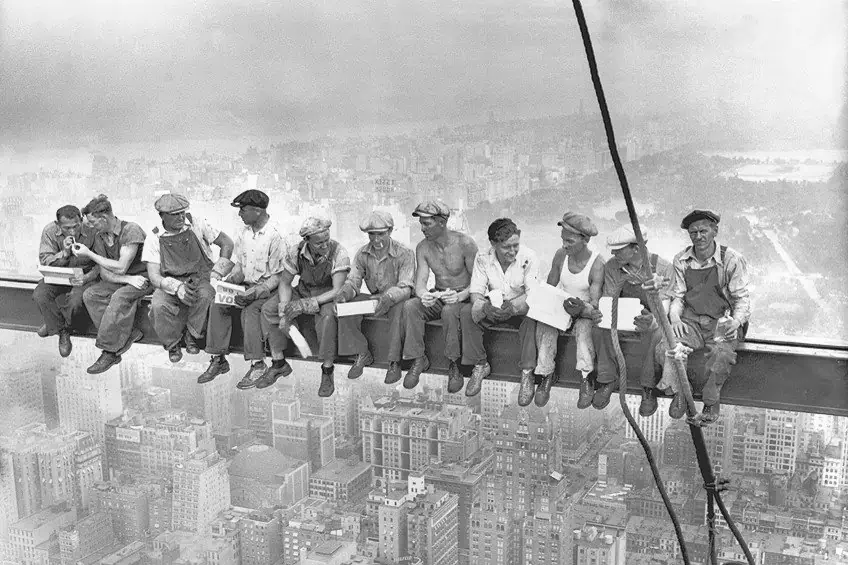Famous Photos – The World’s Most Recognized Photographs
A single photograph can relay a thousand words and in the case of world history, it can encapsulate iconic moments that are unforgettable and profound. In this article, we will explore the top 20 most famous photos in the world that have left their visual mark on history. Keep on reading to see how many of these iconic photos you can identify!
Contents
- 1 Documenting History With Iconic Images
- 2 The Top 20 Most Famous Historic Photographs in Mankind’s History
- 2.1 View from the Window at Le Gras (1827) by Nicéphore Niépce
- 2.2 First Photograph of Machu Picchu (1911) by Hiram Bingham
- 2.3 Titanic Prepared to Leave the Port (1912)
- 2.4 Lunchtime Atop of a Skyscraper (1932) by Charles C. Ebbets
- 2.5 Hyeres (1932) by Henri Cartier-Bresson
- 2.6 Migrant Mother (1936) by Dorothea Lange
- 2.7 The Magnificent Eleven (1944) by Robert Capa
- 2.8 V-J Day In Times Square (1945) by Alfred Eisenstaedt
- 2.9 Mushroom Cloud Over Nagasaki (1945) by Charles Levy
- 2.10 Dalí Atomicus (1948) by Philippe Halsman
- 2.11 Einstein’s Birthday (1951) by Arthur Sasse
- 2.12 Guerillero Heroico (1960) by Alberto Korda
- 2.13 Earthrise (1968) by William Anders
- 2.14 A Man On The Moon (1969) by Neil Armstrong
- 2.15 Lennon & Yoko (1980) by Annie Leibovitz
- 2.16 Prince Charles & Princess Diana (1981) by Tim Graham
- 2.17 Nelson Mandela and Winnie Mandela with Raised Clenched Fists (1990)
- 2.18 Pillars of Creation (1995) by NASA
- 2.19 Falling Man (2001) by Richard Drew
- 2.20 Steve Jobs (2011) by Albert Watson
- 3 Frequently Asked Questions
Documenting History With Iconic Images
What makes an image memorable? It has been said that simply capturing an image during a major historical event is not enough to make an image a “good image” worth remembering. Instead, one has to capture the emotional climax or essence of a defining moment such that the image becomes unforgettable – thus extending itself beyond the realm of art and into a historical discourse.
Over the recent centuries, photographers and photojournalists have been documenting pieces of iconic historical moments and events around the world that have not only exposed parts of the world and political systems for their shortfalls but have also given them historical meaning and a position to be recognized, seen, appreciated, and exposed for their horrific or monumental place in history. One of the most important functions of photography is the ability to historicize events and positive historical moments such that these events can be remembered in the future.
The Top 20 Most Famous Historic Photographs in Mankind’s History
There are more than 100 famous photos from history that you may recognize, however, below, we will only be looking at the top 20 most iconic pictures in mankind’s history that you will surely appreciate for its historical value.
Along with these famous photos are interesting stories that provide insight into the iconic pictures and sitters who were a part of mankind’s largest events.
View from the Window at Le Gras (1827) by Nicéphore Niépce
| Artist Name | Nicéphore Niépce (1765 – 1833) |
| Date | 1827 |
| Medium | Heliograph print |
| Dimensions (cm) | 16.2 x 20.2 |
| Where It Is Housed | Harry Ransom Center, Texas, United States |
This image is perhaps one of the most iconic photos in history since it is the first permanent image captured from the early 19th century. The image was photographed and developed by French inventor Nicéphore Niépce in 1826 and was created using the heliography technique invented by Niépce himself. The image was shot using a camera obscura projected on a pewter plate that was coated in the Bitumen of Judea.

The exposure period was incredibly long and researchers claimed that the process to create the image must have continued for as long as several days. At the time, View from the Window at Le Gras was the only example of a photograph shot by a camera. The photograph was later rediscovered in 1952 after Niépce was identified as the inventor of photography. In 2003, the image was listed as one of 100 photographs that changed the world and were established as the first official photograph in the world.
First Photograph of Machu Picchu (1911) by Hiram Bingham
| Artist Name | Hiram Bingham III (1875 – 1956) |
| Date | 1911 |
| Medium | Photography |
| Dimensions (cm) | Unavailable |
| Where It Is Housed | Unavailable |
The first image of Machu Picchu is one of the best photographs from archeological expeditions in the early 20th century. This black-and-white photograph was captured by the archaeologist Hiram Bingham, who photographed the ruins of Machu Picchu in 1911. At the time, Bingham was traveling by mule with his small team through Cusco and the Urubamba valley. A farmer led the team to a nearby location on top of a mountain, where the ruins of Machu Picchu lay waiting to be discovered.
Bingham and his expedition team hiked for six days, dragging along his camera equipment from Cusco to Aguascalientes, where they investigated other possible sites.
On the way, an innkeeper told Bingham about an overgrown complex lying at the top of the hill. Bingham then sought to find out what this special place on top of the mountain was and later discovered the lost city of Machu Picchu hidden beneath a jungle. Thereafter, Bingham returned a year later to begin expeditions on the site. According to researchers, the city of Machu Picchu was built as a royal estate for an Inca king and dated to around the mid-15th century. Other theories about the function of the Inca city included theories that it was a sacred hub where various prominent political and religious leaders gathered.
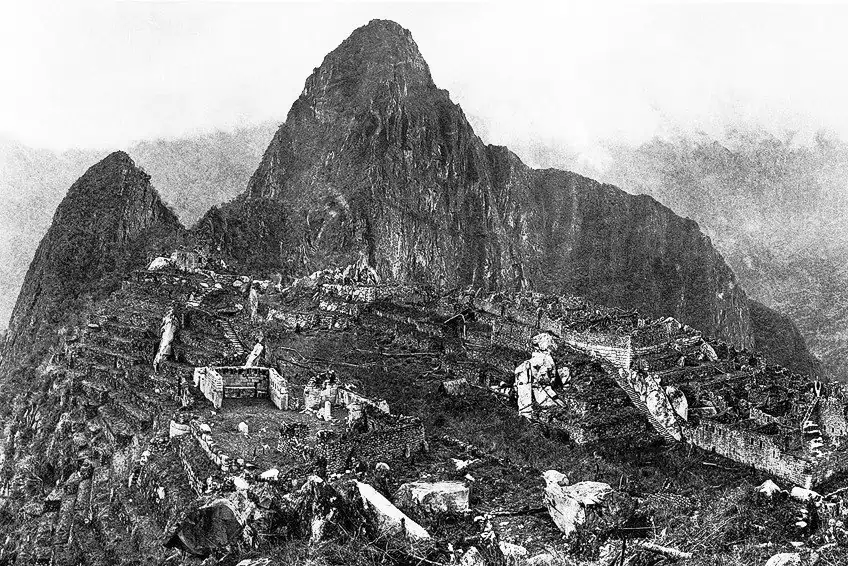
Titanic Prepared to Leave the Port (1912)
| Artist Name | Unknown |
| Date | 1912 |
| Medium | Photography |
| Dimensions (cm) | Unavailable |
| Where It Is Housed | Unavailable |
Titanic Prepared to Leave the Port is among the most iconic pictures that nostalgically reminds us of the last time the Titanic was seen. The Titanic was a famous ship, which at its time, became the second largest ocean liner shipwreck in the world. Many will remember that the Titanic was discovered only 70 years after she sank, dragging down over 1500 passengers. The sinking of the Titanic was one of the largest maritime disasters of its time while also being the largest ship in the 1900s.
Titanic departing Southampton on 10 April 1912; Francis Godolphin Osbourne Stuart, Public domain, via Wikimedia Commons
Aboard the Titanic were also prominent members of society who were considered to be the wealthiest people from Great Britain, Ireland, and other parts of Europe. These passengers sought a better life in the United States and were fully prepared to leave behind their old lives, not knowing the disaster that lay ahead of them. Only 705 people survived the shipwreck after hitting an iceberg around 11:40 PM. Sadly, after hitting a major iceberg, the Titanic sank within two hours. The image thus serves as a haunting reminder of the tragedy in 1912 that awaited many of its eager and hopeful passengers.
Lunchtime Atop of a Skyscraper (1932) by Charles C. Ebbets
| Artist Name | Charles Clyde Ebbets (1905 – 1978) |
| Date | 1932 |
| Medium | Photography |
| Dimensions (cm) | Unavailable |
| Where It Is Housed | Unavailable |
Lunchtime Atop a Skyscraper is the most iconic photo of all time. This historical image was shot by Charles Clyde Ebbets, who was one of the most famous American photographers of the early 20th century who sadly passed away from cancer. Lunchtime Atop of a Skyscraper was one of Ebbets’ most famous photographs, which was believed to be a publicity stunt used to promote the building of the RCA building.
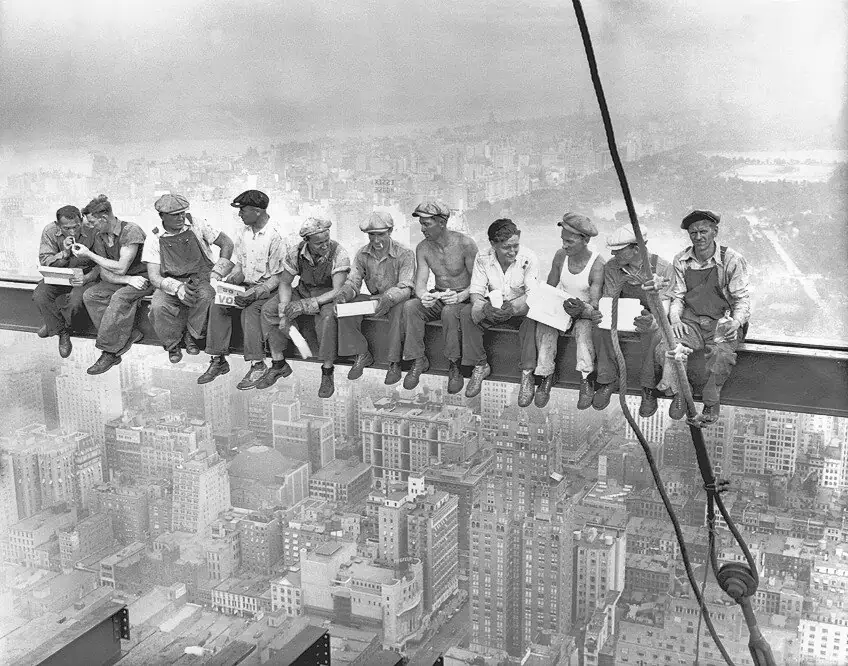
It was speculated that the image was curated by the Rockefeller Center along with the workers in the image who served as real evidence of the effort put into the construction. Lunchtime Atop a Skyscraper has been ranked among the best photographs of world history.
Hyeres (1932) by Henri Cartier-Bresson
| Artist Name | Henri Cartier-Bresson (1908 – 2004) |
| Date | 1932 |
| Medium | Gelatin silver print |
| Dimensions (cm) | 20 x 29.5 |
| Where It Is Housed | Metropolitan Museum of Art, New York City, United States |
Henri Cartier-Bresson was one of the most prolific photographers of the 20th century who was a pioneer of 35mm film photography. Cartier-Bresson was also considered to be an expert in candid and street photography who championed the “decisive moment” concept. For Bresson, his approach was defined as a way of life and alignment of the head, heart, and the artist’s eye.
Hyeres was one of the artist’s most famous pictures that encapsulated his concept of the decisive moment by capturing a bicycle rider on the cusp of exiting the sidewalk. The image appears to be candid and taken as though it were an accidental shot, however, the image’s successful decisive moment was captured by Bresson’s masterful eye for leading lines and slow shutter speed.
Migrant Mother (1936) by Dorothea Lange
| Artist Name | Dorothea Lange (1895 – 1965) |
| Date | 1936 |
| Medium | Photograph; gelatin silver print |
| Dimensions (cm) | 28.3 x 21.8 |
| Where It Is Housed | Museum of Modern art, New York City, United States |
Migrant Mother by Dorothea Lange is one of the most famous pictures shot in 1936. The image was taken in Nipomo, California during Lange’s assignment by the Farm Security Administration. The print is currently housed at the Museum of Modern art and portrays the image of a mother staring into the distance, while her children gather around her. Since the photograph was published in the 1930s, it has become an iconic image of the Great Depression.
What makes the image powerful is that the children’s faces are hidden with their backs turned away from the camera, away from the photographer, and away from the viewer.
The highlight of the image is the mother’s face, which is often uncredited in many descriptions of the image. Migrant Mother was also one of the photographs that helped win Lange her Guggenheim fellowship in the 1940s and went on to inspire a novel by John Steinbeck, which was published in 1939. The mother in the image is Florence Owens Thompson who was born in Oklahoma on Indian territory. After her husband had passed away, she was forced to work in fields and later on as a migrant farmworker in Arizona. The manner in which the photograph was taken has also been the subject of debate surrounding the ethics of photography and the situation in which Lange photographed Owens. 23 years later, Lange reported that she did not ask Thompson her name or any questions about her background, rather she told only mentioned to Lange her age and that she had been living on frozen vegetables from the fields. Lange also recalled that Thompson sold her tires from a car to purchase food.
Migrant Mother (1936) by Dorothea Lange; Dorothea Lange, Public domain, via Wikimedia Commons
According to Thompson, Lange promised that her photo would not be published, however, it was sent to the San Francisco news before it reached the Resettlement Administration and the pictures were published immediately along with headlines alluding to the starving migrants of Nipomo. At one point in the 1970s, Thompson was quoted claiming that she wished that Lange had not photographed her because she didn’t “get a penny out of it”. At the time, Lange was funded by the government and the image was considered part of the public domain. As such, Lange was not entitled to any royalties herself, however, the image did enable her heightened public recognition in her community.
The Magnificent Eleven (1944) by Robert Capa
| Artist Name | Robert Capa (1913 – 1954) |
| Date | 1944 |
| Medium | Photography |
| Dimensions (cm) | Varied |
| Where It Is Housed | International Center of Photography, New York City, United States |
The Magnificent Eleven is a famous series of photographs portraying the wartime action of “D-Day”, better known as the Normandy Landings of World War II. The images were photographed by Robert Capa in 1944, who was part of the team that landed early on Omaha beach. Capa shot more than 106 images but the original eleven images were destroyed in a processing accident in London.
These famous D-Day images were also the inspirational backdrop to the movie Saving Private Ryan (1998), directed by Steven Spielberg. The soldiers identified in the photos include Edward Regan and Huston Riley as well as a combat engineer known as James E. Terrell. The printed copies of the photographs are currently housed at the New York International Center of Photography.
V-J Day In Times Square (1945) by Alfred Eisenstaedt
| Artist Name | Alfred Eisenstaedt (1898 – 1995) |
| Date | 1945 |
| Medium | Photograph |
| Dimensions (cm) | Unavailable |
| Where It Is Housed | Unavailable |
V-J Day in Times Square is a famous photograph that many people would recognize simply as the most iconic kiss of the 20th century. The image is romantic and reminiscent of the United States Victory Over Japan Day, portraying a passionate couple kissing in the middle of the street. The image was shot by German photographer Alfred Eisenstaedt and was published a week after it was shot at New York’s Times Square. The end of the war was announced by President Harry S. Truman at 7:00 in Times Square.
At the time, a US navy sailor spontaneously decided to kiss a stranger and Eisenstaedt happened to be in the city where he skillfully captured the spur-of-the-moment kiss.
Eisenstadt first captured the image using his Leica IIIa camera and recalled the event at Times Square decades later, claiming that on the day he saw a sailor running on the street grabbing every girl in sight. He then turned around to spot the sailor kissing a nurse. He shot exactly four images within the space of a few seconds. It was almost overnight that his image of the sailor and the young nurse became a cultural reminder of the United States’ victory over Japan. Another image of the exact same moment was captured by another photographer, Victor Jorgensen, who titled his image Kissing the War Goodbye.
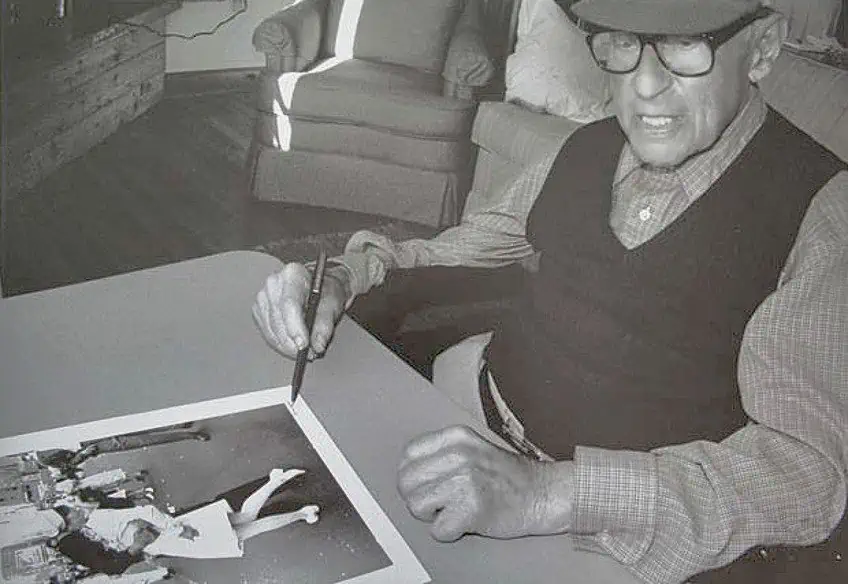
Mushroom Cloud Over Nagasaki (1945) by Charles Levy
| Artist Name | Charles Levy (1918 – 1997) |
| Date | 1945 |
| Medium | Photograph |
| Dimensions (cm) | Unavailable |
| Where It Is Housed | The National Archives and records administration, Minnesota Historical Society, Minnesota, United States |
Mushroom Cloud Over Nagasaki was taken in 1945 by Lieutenant Charles Levy and is recognized as one of the most unforgettable images of the 20th century. This famous image was taken after an atomic bomb was dropped over Nagasaki during World War II. The huge mushroom cloud was the result of the second atomic bomb and was described as a huge cloud of smoke and dust, which was also incredibly toxic. The image is haunting and stands as a bleak reminder of the power of an atomic bomb and its potential for mass nuclear destruction. It was estimated that the cloud spilling over Nagasaki was approximately 45,000 feet tall and was dropped by the United States a few days after the first atomic bomb was dropped over Hiroshima.
The image is thus a reminder of the destruction of war, which claimed over 200,000 lives across Nagasaki and Hiroshima.
The Lieutenant was 26 years old when he captured the devastating image while flying the B29 aircraft called The Great Artiste. According to Levy’s statement on witnessing the bombing, he recalled that the explosion was brighter than “double daylight” itself, even from simply viewing it from the plane. The colors of the explosion illuminated the atmosphere with smoky hues of purple, white, red, and other colors that resembled “boiling coffee”. Levy also claimed that the explosion “looked alive”.
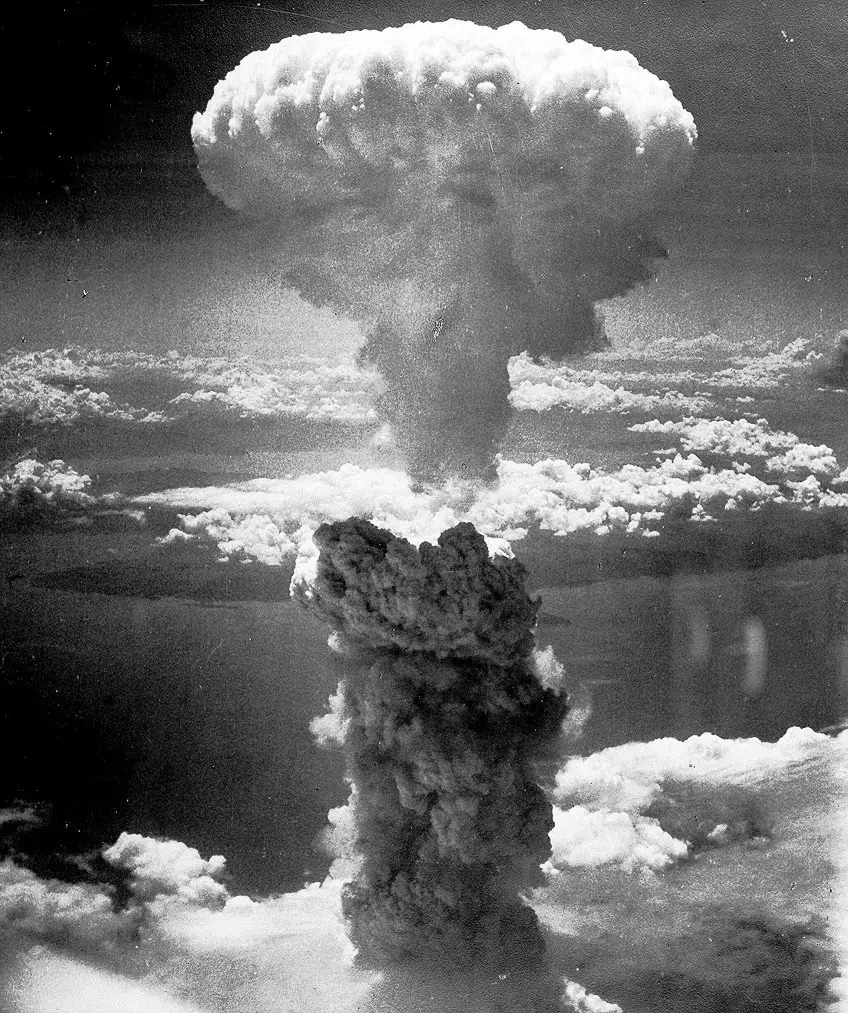
Aside from the atrocities that the atomic bombing had on Japan and the long-term effects of radiation on its people, the image also became a symbol of America’s power and the dawn of the atomic age. It is useful to remember that the power of such weapons of mass destruction in the early 20th century was only a small demonstration of the lengths of destruction that science is capable of.
Dalí Atomicus (1948) by Philippe Halsman
| Artist Name | Philippe Halsman (1906 – 1979) |
| Date | 1948 |
| Medium | Photography; gelatin silver print |
| Dimensions (cm) | 25.8 x 33.3 |
| Where It Is Housed | The Museum of Modern Art, New York City, United States |
Dalí Atomicus is one of the most famous artistic photos taken by Philippe Halsman in collaboration with Spanish artist Salvador Dalí. The playful image demonstrates the weightless surrealist photography approach proposed by Dalí and is one of the most iconic images from the pair’s collaboration. The photograph also features one of Dalí’s famous paintings Leda Atomica (1949) and can be seen in the right-hand corner where Dalí is shot midair.
Dalí Atomicus (1948) by Philippe Halsman; Philippe Halsman, Public domain, via Wikimedia Commons
Halsman was best known for taking jumping portraits of various political figures and celebrities. He applied the jumping strategy to unmask the celebrity or politician he was photographing and capture them in the moment of jumping. He believed that this approach evoked the sitter’s true appearance, without a façade of posing for the camera.
Einstein’s Birthday (1951) by Arthur Sasse
| Artist Name | Arthur Sasse (1908 – 1975) |
| Date | 1951 |
| Medium | Photograph |
| Dimensions (cm) | Unavailable |
| Where It Is Housed | Unavailable |
Einstein’s birthday is proof that scientists are not always the bearers of grim and serious news. American UPI photographer Arthur Sasse shot this joyful image of Albert Einstein, which became his career-defining photograph. The image showing Albert Einstein sticking his tongue out in a playful manner was taken at the physicist’s 72nd birthday hosted at the Princeton Club. After the photograph was taken, Einstein commissioned nine additional prints for his private collection.
The power of this playful portrait lay in its ability to help broaden the representation of Einstein as more than just a physicist – as a man who can also have serious fun! The image gained widespread popularity and went on to be included on stickers, posters, and even T-shirts. Photographed in 1951, the image became the most expensive Albert Einstein photograph ever sold and was auctioned for approximately $72,300. It is believed that Einstein himself selected the image to comically print on greeting cards for his friends, as a remembrance of his “nutty professor-like” personality at the age of 72.
Guerillero Heroico (1960) by Alberto Korda
| Artist Name | Alberto Díaz Gutiérrez (Better known as Alberto Korda) (1928 – 2001) |
| Date | 1960 |
| Medium | Photography |
| Dimensions (cm) | Unavailable |
| Where It Is Housed | Unavailable |
Guerillo Heroico is a famous 20th-century image of the Marxist revolutionary figure Che Guevara, which was shot by Cuban photographer Alberto Korda. Korda first began taking pictures in the 1920s and went on to become one of the most famous documentary photographers of the Cuban revolution. Korda was also an expert at black and white photography as well as curating compelling compositions during his travels with Fidel Castro. Most of the images shot by Korda during the Cuban Revolution eventually became iconic symbols of the revolution itself. Korda always operated at his own pace and followed his own rules as a photographer, however, the extent of his relationship with Castro remains unresolved.
The image of Che Guevara was then championed as a global symbol of the rebellion.
In the late 60s and 70s, Korda chose to focus on underwater photography and later passed away in 2001 due to a fatal heart attack while presenting at an exhibition. A portion of his legacy was then transformed into a documentary called Kordavision (2006) directed by Hector Cruz Sandoval. In the 1960s Cuba, a memorial service was held for the victims of a French freighter explosion, which occurred on the 4th of March as it was unloading grenades and munitions. Fidel Castro claimed that it was an act of sabotage and blamed the tragedy on the United States. Che Guevara, born Ernesto “Che” Guevara, was an Argentine figure of the Cuban Revolution whose stylized photograph by Korda became a countercultural symbol of rebellion in popular culture and was included in artistic imagery on embroidery, digital artwork, silkscreens, sculptures, drawings, and other reproductions.
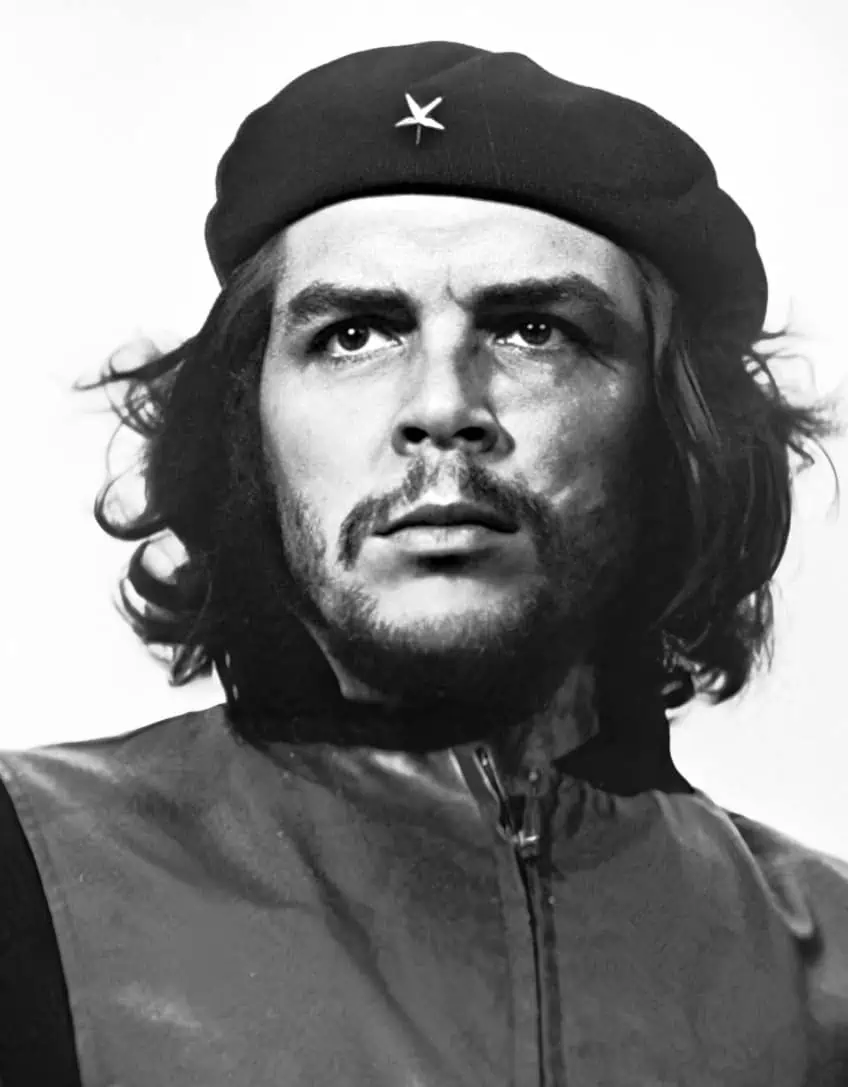
Korda claimed that he was not paid for the image despite being an avid supporter of Communism and the Cuban Revolution. In 1968, the black, red, white, and yellow stylized image of Che Guevara was recreated by Jim Fitzpatrick and published in Provos magazine. The Provo groups were a Dutch anarchist group and counterculture movement that emerged in the mid-1960s. Such counterculture groups were formed to elicit violent responses from authorities using non-violent means and were regarded as a hippie form of protest. Needless to say, the image of Che Guevara was immortalized across the globe as a symbol of anger, struggle, stoicism, and the Cuban Revolution.
Earthrise (1968) by William Anders
| Artist Name | William Alison Anders (1933 – Present) |
| Date | 1968 |
| Medium | Photography |
| Dimensions (cm) | Unavailable |
| Where It Is Housed | NASA, Washington, D.C., United States |
Photographed in December 1968 during NASA’s Apollo 8 mission, Earthrise is a famous photograph of the earth shot from the moon by astronaut William Anders. The image was described as one of the most influential environmental images ever taken. In 1966, a rather crude black-and-white image was released and in 1968, a color version was produced, resulting in a clear shot that was developed on 70mm color film. Additionally, the image was also dubbed one of the most famous pictures in the history of photography in 1988.
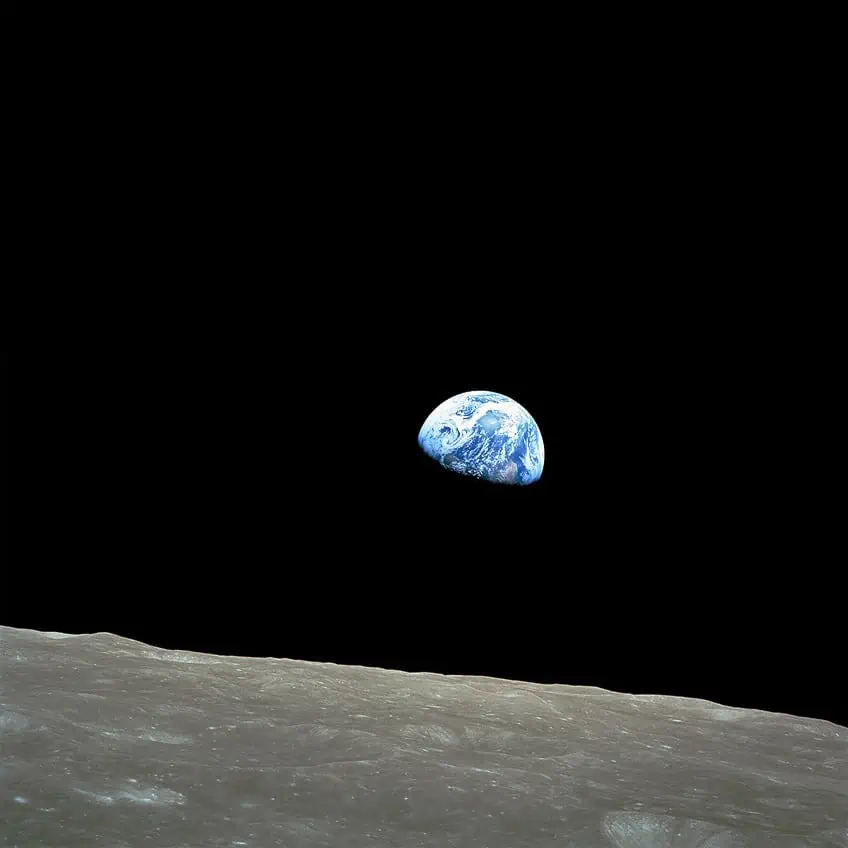
According to reports, the NASA technicians were so excited about the image that they could not wait for it to be developed as per the usual process. The team even traveled four hours to Corpus Christie, Texas, to a small color lab, now known as R&R photo techniques, to develop the film. Later in 2013, NASA released a video to commemorate the 45th anniversary of the mission, which was based on how the image was photographed. The video was a simulation created using the information from the Lunar Reconnaissance Orbiter spacecraft and demonstrated how the astronauts viewed the earth in space as it rotated 90 degrees clockwise, thus mimicking the perspective in Earthrise.
A Man On The Moon (1969) by Neil Armstrong
| Artist Name | Neil Alden Armstrong (1930 – 2012) |
| Date | 1969 |
| Medium | Photograph |
| Dimensions (cm) | Unavailable |
| Where It Is Housed | NASA, Washington, D.C., United States
|
A Man on the Moon was photographed by Neil Armstrong in 1969 and demonstrates the power of photography to capture the vastness and the wonder of space. This iconic image was celebrated for its commemoration of the Apollo 11 mission and illustrates the astronaut Buzz Aldrin as he walks across the surface of the moon. Neil Armstrong was the commander of the Apollo 11 mission who shot the image using a 70mm lunar surface camera. During the Apollo 11 mission, Armstrong and Aldrin trekked across the sea of tranquility for about two and a half hours as their other teammate, Michael Collins, orbited in space above them.
Buzz Aldrin on the Moon in a photograph taken by Neil Armstrong; Neil Armstrong, Public domain, via Wikimedia Commons
An aspect of this image that makes it such a powerful image is the reflection seen on the astronaut’s visor. The reflective quality of Aldrin’s suit became one of the most powerful aspects of the image where we can observe the two lunar horizons. The Apollo astronauts’ visors were lined with gold to protect their eyes from the rays of the sun. As Neil Armstrong photographed the image, he not only presented an image of a man on the moon, but he also highlighted two human beings observing each other across the dusty terrain of the moon for the first time. The image is one of its kind and almost alien.
Lennon & Yoko (1980) by Annie Leibovitz
| Artist Name | Annie Leibovitz (1949 – Present) |
| Date | 1980 |
| Medium | Polaroid |
| Dimensions (cm) | 30.50 x 31 |
| Where It Is Housed | National Portrait Gallery, London, United Kingdom |
In 1980, American photographer Annie Leibovitz shot this beautiful composition for Rolling Stone. The photograph portrays artist Yoko Ono with the musician John Lennon, who was her husband, positioned on a cream carpet. Ono wore a long-sleeved black shirt and blue jeans while Lennon was fully nude. Lennon curled his body in a fetal position while wrapping his body around his wife. The couple’s eyes were also closed as Lennon planted a loving kiss on Ono’s face.
Leibovitz in front of her More Demi Moore Vanity Fair cover photo, 2008; Marc Silber of www.silberstudios.com Carmel, CA, CC BY 2.0, via Wikimedia Commons
He also framed her head with his arm in a protective gesture. Yet, the two were unaware that this would be their last image together since only hours later, Lennon was murdered by his former security guard, Mark David Chapman. The image is remembered as one of history’s greatest expressions of love along with its resounding theme of loss due to its ill timing and intimate display of affection. It is also powerful in that it demonstrates Ono’s expression of self-possession through her fully-clothed body contrasted by her naked husband.
Prince Charles & Princess Diana (1981) by Tim Graham
| Artist Name | Tim Graham (1948 – Present) |
| Date | 1981 |
| Medium | Photograph |
| Dimensions (cm) | Unavailable |
| Where It Is Housed | Unavailable |
Shot by Tim Graham in 1981, this famous image of Prince Charles and Princess Diana was one of the most widely-circulated images in the press at the time, capturing the couple’s wedding-day bliss. The image quickly became a symbol of the fairytale ending of Princess Diana, who captivated millions across the globe. Princess Diana was the first British citizen to marry a royal monarch in over 300 years; she tied the knot with Prince Charles on 29 July 1981. In the photograph, Diana wore a glamorous yet elegant silk taffeta gown designed by David and Elizabeth Emanuel. Her dress was also designed with antique lace, pearls, sequins, and of course, a 25-foot train – which was historical itself for being the longest train for a royal wedding gown in British royal history.
This image of Prince Charles & Princess Diana was shot on the balcony of Buckingham Palace where the two shared a public kiss. Princess Diana, known as the Princess of Wales, was also one of the most loved members of the royal family who tragically passed away in an unfortunate car crash. During her tenure, Diana represented Queen Elizabeth II at multiple functions hosted by Commonwealth countries. She was also celebrated across international media for her unconventional approach to royal fashion and charitable personality. In 1997, crowds across the world mourned Diana’s death, which was deemed an unlawful killing and led to an investigation by the London Metropolitan police. Thereafter, her death left a significant impact on British society as well as the public’s view of the royal family.
Nelson Mandela and Winnie Mandela with Raised Clenched Fists (1990)
| Artist Name | Unknown |
| Date | 1990 |
| Medium | Photography |
| Dimensions (cm) | Unavailable |
| Where It Is Housed | Unavailable |
Nelson Mandela and Winnie Mandela with Raised Clenched Fists is perhaps one of the most powerful images in history portraying the anti-apartheid hero Nelson Mandela holding his wife, Winnie Mandela’s hand, as he marches out of prison. The image was shot on 11 February 1990, the day that Mandela was released from his 27-and-a-half-year-long imprisonment. The image was taken late in the afternoon when Mandela had been released after three decades. In the years before his release, many South Africans had not seen or heard from Mandela yet his presence was incredibly profound.
Once he was released, thousands of supporters came out in the streets to witness his arrival and catch a glimpse of the legend who fought for the injustices of the apartheid system and racial segregation.
In 1994, Mandela became the first Black president of South Africa following intense opposition. Among the many images of Nelson Mandela, this image proves to be the most iconic since it captures the height of the moment when Nelson Mandela looks to the crowd alongside his wife and acknowledges the evident atmosphere of victory through a symbol of raised fists, which signaled the power of freedom and a promise of the new democratic South Africa. Today, the photograph is a reminder of the struggle of heroes during the apartheid regime and reminds the world of South Africa’s first triumph against discrimination, racial injustice, and segregation.
Pillars of Creation (1995) by NASA
| Artist Name | NASA |
| Date | 1995 |
| Medium | Photograph |
| Dimensions (cm) | Unavailable |
| Where It Is Housed | NASA, Washington, D.C., United States |
These ethereal interstellar elephant trunks of dust are located in the eagle nebula and were captured by the Hubble Space Telescope in 1995. These elephant trunks were initially discovered by John Charles Duncan in the early 20th century. John Charles Duncan was a famous American astronomer who discovered these Pillars of Creation and produced a plate using Mount Wilson’s observatory 60-inch telescope. The astronomers responsible for photographing this magnificent image were Jeff Hester and Paul Scowen.
The iconic Pillars of Creation image is recognized as a global cultural image, which became famous through National Geographic, which used the image to celebrate its 20th anniversary.
The pillars in the image are made-up of cool molecular hydrogen, which are dust particles that were captured in the process of being eroded. The erosion was caused by photoevaporation from the UV light of the hot stars surrounding the pillars.
Pillars of Creation (1995) by NASA; Credit: NASA, Jeff Hester, and Paul Scowen (Arizona State University), Public domain, via Wikimedia Commons
NASA has also revisited and updated the image to celebrate the anniversary of the Hubble Space Telescope where astronomers would come to recreate the image using high-res equipment. The Pillars of Creation were subsequently recaptured in 2014 and 2022 to reveal the brilliance of these structures in all their glorious detail.
Falling Man (2001) by Richard Drew
| Artist Name | Richard Drew (1946 – Present) |
| Date | 2001 |
| Medium | Photography |
| Dimensions (cm) | Unavailable |
| Where It Is Housed | Public domain |
The Falling Man is one of the most famous photographs from the September 11 attacks on New York City, photographed by an Associated Press photojournalist, Richard Drew. The image depicts a man photographed as he was falling from the World Trade Center and remains unidentified to this day. It is unclear whether the man jumped from the building to escape the smoke or whether he was searching for safety, but the image remains one of the harshest and most impactful images from the 9/11 attacks. It was estimated that over 200 people fell to their deaths due to the fires that broke out in the building, leaving more than 2600 people dead.
When the photo was released, it quickly gained popularity and reach across the globe, and first appeared in the New York Times in 2001. It was speculated that the man falling from the building was Norberto Hernandez, who was a pastry chef working at Windows on the World. Windows on the World was a complex of restaurants located on the 106th floor of the tower. Other speculations about the man’s cause of death were linked to his exposure to the extreme heat and strong desire to escape the flames, so much so that he had no choice but to jump. The September 911 attack remains one of the most tragic events in the history of the United States and is one that most people cannot forget after witnessing the horrific sight of people jumping off of a building to escape the danger of the fire.
Steve Jobs (2011) by Albert Watson
| Artist Name | Albert Watson (1942 – Present) |
| Date | 2011 |
| Medium | Photography |
| Dimensions (cm) | Unavailable |
| Where It Is Housed | Unavailable |
This portrait of Steve Jobs is perhaps one of the most widely circulated images of the 21st century. This iconic headshot of Steve Jobs was photographed as a commemorative image to define Jobs’ contribution to technology, presented in a simple black-and-white photograph. Steve Jobs was one of the most famous figures of the 21st century who was best known as the CEO of Apple as well as a major shareholder of Pixar.
He was also considered to be a pivotal figure in the personal computer revolution of the 1970s. Albert Watson is a famous Scottish fashion photographer who has photographed over 100 covers for Vogue as well as 40 magazine covers for Rolling Stone. The portrait of Steve Jobs was originally shot in 2006 but was later re-adapted into a 2011 commemorative portrait. The portrait was uploaded on Apple’s website after the announcement of Steve Jobs’ death on October 5th, 2011.
These famous historic photographs contain memories and snapshots of the world during its most pivotal moments in mankind’s history. Photography as a medium for historicization is one of the most powerful lessons in art that every artist should be aware of.
Take a look at our most famous photos webstory here!
Frequently Asked Questions
What Is the Oldest Photograph Ever?
The oldest photograph is considered to be an 1826 image called View from the Window at Le Gras, which was shot by Joseph Nicéphore Niépce, who used an exposure period of eight hours.
What Is the Most Famous Photograph in History?
The most famous photograph in history is considered to be Man on a Moon, which was taken in 1968 by NASA and credited to Neil Armstrong. Following this is another highly famous image called Lunch Atop a Skyscraper, taken by an unknown photographer in 1932.
Who Are the Top Three Most Famous Contemporary Photographers in the World?
The top three most famous Contemporary photographers in the world are Ansel Adams, Andreas Gursky, and Annie Leibovitz.
Jordan Anthony is a Cape Town-based film photographer, curator, and arts writer. She holds a Bachelor of Art in Fine Arts from the University of the Witwatersrand, Johannesburg, where she explored themes like healing, identity, dreams, and intuitive creation in her Contemporary art practice. Jordan has collaborated with various local art institutions, including the KZNSA Gallery in Durban, the Turbine Art Fair, and the Wits Art Museum. Her photography focuses on abstract color manipulations, portraiture, candid shots, and urban landscapes. She’s intrigued by philosophy, memory, and esotericism, drawing inspiration from Surrealism, Fluxus, and ancient civilizations, as well as childhood influences and found objects. Jordan is working for artfilemagazine since 2022 and writes blog posts about art history and photography.
Learn more about Jordan Anthony and about us.
Cite this Article
Jordan, Anthony, “Famous Photos – The World’s Most Recognized Photographs.” artfilemagazine – Your Online Art Source. October 23, 2023. URL: https://artfilemagazine.com/famous-photos/
Anthony, J. (2023, 23 October). Famous Photos – The World’s Most Recognized Photographs. artfilemagazine – Your Online Art Source. https://artfilemagazine.com/famous-photos/
Anthony, Jordan. “Famous Photos – The World’s Most Recognized Photographs.” artfilemagazine – Your Online Art Source, October 23, 2023. https://artfilemagazine.com/famous-photos/.


